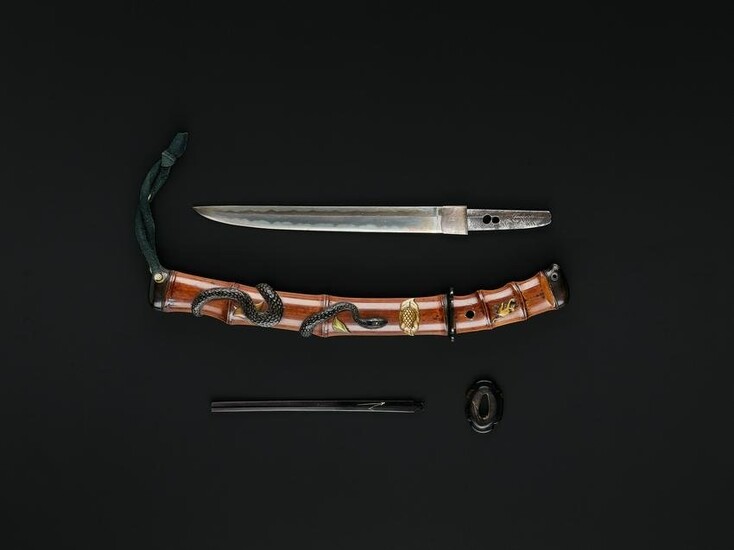IKKO: A TANTO IN SUPERB INLAID SANSUKUMI SAYA
HASEGAWA IKKO: A TANTO IN SUPERBLY INLAID SAYA WITH SANSUKUMI
The saya by Hasegawa Ikko
Japan, 19th century
The blade:
Moroha-zukuri, the hamon is gunome in nie-deki and found to both ends of the blade, with faint nie-utsuri, the hada is itame. The silver habaki with diagonal file marks and dew drops. The nakago is ubu with two mekugi-ana, the yasurime is sujikai, the tip is kuri jiri.
The mounting:
The dark wood wo-part kogai with mother-of-pearl inlay, the fuchi and kojiri are plain while the kashira is inlaid with a slug in translucent horn. The gilt mekugi in the form of mon. The bamboo saya is superbly inlaid in ebony, stained bone, and translucent horn with leaves, an acorn, the menuki in the form frogs, and a long coiled snake, the snake and frog both with gold-inlaid eyes. Signed within a reserve IKKO (Hasegawa Ikko).
NAGASA 18.8 cm, LENGTH 31.8 cm (the koshirae)
Condition: Very good condition with minor surface wear, the hand guard with a small loss.
Provenance: Henri Baudoin, Etienne Ader, Hotel Drouot, Paris, Collection J. Jacques Reubell, 13-16 December, 1933, lot 766.
The combination of snake, frog, and slug (or snail) constitutes the sansukumi motif, meaning ‘mutual control’. The snake will consume the frog, however there is a catch – the frog has already eaten a poisonous snail, so too the snake must perish.
Auction comparison:
For an inlaid bokuto (wooden sword) by the artist see Bonhams, Fine Japanese Art, 14 May 2015, London, lot 298 (sold for 13,750 GBP).
View it on
Sale price
Estimate
Time, Location
Auction House
HASEGAWA IKKO: A TANTO IN SUPERBLY INLAID SAYA WITH SANSUKUMI
The saya by Hasegawa Ikko
Japan, 19th century
The blade:
Moroha-zukuri, the hamon is gunome in nie-deki and found to both ends of the blade, with faint nie-utsuri, the hada is itame. The silver habaki with diagonal file marks and dew drops. The nakago is ubu with two mekugi-ana, the yasurime is sujikai, the tip is kuri jiri.
The mounting:
The dark wood wo-part kogai with mother-of-pearl inlay, the fuchi and kojiri are plain while the kashira is inlaid with a slug in translucent horn. The gilt mekugi in the form of mon. The bamboo saya is superbly inlaid in ebony, stained bone, and translucent horn with leaves, an acorn, the menuki in the form frogs, and a long coiled snake, the snake and frog both with gold-inlaid eyes. Signed within a reserve IKKO (Hasegawa Ikko).
NAGASA 18.8 cm, LENGTH 31.8 cm (the koshirae)
Condition: Very good condition with minor surface wear, the hand guard with a small loss.
Provenance: Henri Baudoin, Etienne Ader, Hotel Drouot, Paris, Collection J. Jacques Reubell, 13-16 December, 1933, lot 766.
The combination of snake, frog, and slug (or snail) constitutes the sansukumi motif, meaning ‘mutual control’. The snake will consume the frog, however there is a catch – the frog has already eaten a poisonous snail, so too the snake must perish.
Auction comparison:
For an inlaid bokuto (wooden sword) by the artist see Bonhams, Fine Japanese Art, 14 May 2015, London, lot 298 (sold for 13,750 GBP).



